Hi,
If you are approaching Vermeer's art for the first time, you couldn't choose a better moment.
There has never been such an abundance of Vermeer-related publications, high-quality prints, digital images and special exhibitions as in the last decades. Moreover, the great part of Vermeer's paintings have been restored by the most exacting standards and can now be appreciated like never before. Obviously, the best way to get to know Vermeer's paintings is to visit the museums where they are housed. Unfortunately, this is not always possibleFor a brief overview of Vermeer's paintings, you can refer to the attached video.
However, there is a wide range a wide range of informative publications regarding Vermeer's art and life, many of which include fine reproductions that will bring the readers as close to Vermeer's pictures as is possible without seeing the original. Many can be comfortably purchased through online book stores.
Please don't hesitate to email me if you need further information; I'd be happy to assist. I hope this information helps you embark on your journey with Vermeer's art!
Jonathan Janson
Author and webmaster of Essential Vermeer
QUICK SEARCH Vermeer's paintings
Which Resources First?
REPRODUCTIONS. First of all, you will probably be looking for a book with good reproductions of Vermeer's complete oeuvre along with a straightforward overview of his life and artistry. The quality of reproductions varies notoriously from book to book. The three publications reviewed below feature all of Vermeer's paintings with more than acceptable degree of accuracy.
BIOGRAPHY. Secondly, you will probably want to know something about Vermeer's life. There are two excellent volumes available. Until the mid-1800s, Vermeer's painting had largely been forgotten so historians knew nothing of his life. Although great progress was made during the first half of the twentieth century, it was not until 1986, when the American economist John Michael Montias published his Vermeer and His Milieu: A Web of Social History that the first clear picture of Vermeer's life and extended family was definitively documented..
However, Gregor Weber has recently published a remarkably thorough review of Vermeer's ties to the Delft Jesuits and the painter's relationship with the camera obscura; Johannes Vermeer: Faith, Light and Reflection, which It should be considered good reading for the more attetentive mid-level Vermeer readers.
Anthony's Bailey's paperback Vermeer: A View of Delft is an eminently readable account of Vermeer's life which affords a suggestive picture of Vermeer's family and professional life, his hometown, Delft, and seventeenth-century Dutch life at large.
Walter Liedtke's Vermeer: The Complete Paintings offers a succinct but penetrating account of the artist's life and pictorial evolution.
ARTISTRY. Today, Liedtke's Vermeer: The Complete Paintings constitutes the best overall study of the artist. Liedtke's precision and intuition make the book reliable and readable.
The other two books listed in the first two categories offer accounts of Vermeer's work and life, however, more complex issues of artistry and iconographic meaning are not investigated at great length. One of the most suggestive and widely read interpretations of Vermeer's art is Lawrence Gowing's monograph, Vermeer, although it demands the reader's full attention and may pose some problems for readers whose mother tongue is not English. The other two volumes, A Study of Vermeer by Edward Snow and the catalogue of the historic Washington/The Hague Vermeer 1994 exhibition should be considered as well.
DUTCH GENRE PAINTING. When you feel a bit more comfortable with the basics of Vermeer's life and art, you may wish to explore the Dutch genre painting (scenes of everyday life) and the artists of the so-called Delft School. The three volumes suggested below can be considered classics. Especially interesting is the lushly illustrated Dutch Seventeenth-Century Genre Painting: Its Stylistic and Thematic Evolution by Wayne Franits.
Click on the book titles to access Amazon.com online bookstore.
1. Oeuvre and Reproductions
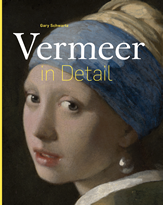
by Garry Schwartz
2017
Vermeer in DetailGarry Schwartz, Vermeer in Detail (New York: Harry N. Abrams, 2017). by Garry Schwartz is an excellent introduction to the Dutch master through one hundred and twenty the most attractive details of his paintings, each one finely illustrated with state-of-the-art printing. Vermeer's artistry captures everyday objects, female figures, and their expressive faces with a realism that's both captivating and utterly convincing. Yet, beyond the tangible, his paintings exude a poetic essence that enchants viewers, guiding them into a dreamlike realm. Despite their lifelike appearance, Vermeer's creations beckon the observer to let their imagination wander. This book delves into one hundred and twenty such details, organized into ten themes reflecting Vermeer's diverse and sometimes unexpected fascinations. For instance, in a departure from typical Dutch art of his era, Vermeer intriguingly incorporates paintings from other masters into his interiors, a nod of reverence. Among the myriad details, the visages of young women, adorned with shawls, caps, ribbons, and curls, stand out. These faces captivate us, and at times, seem to invite us into their intimate worlds. Accompanying each detail is an insightful commentary discussing the subject, technique, pictorial methods, the history of the depicted objects, comparative motifs, scholarly perspectives, and more.
Concise entries and illustrations of the 37 paintings currently given to Vermeer, including the disputed attributions. Preceded by a capsule biography.
Purchase of the volume provides the buyer with exclusive access to a website with high-resolution images of the complete paintings.
by Karl Schütz
2015
Vermeer: The Complete WorksKarl Schütz, Vermeer: The Complete Works (Berlin: TASCHEN, 2020) by Karl Schütz is extra-large edition brings together the complete catalogue of Vermeer's work, presenting the calm yet compelling scenes so treasured in galleries across Europe and the United States, compiled into one monograph with reproductions and detials of utmost quality. With brand new photography of many works, Vermeer's restrained but richly evocative repertoire of domestic actions—ranging from letter writing to music making to preparations in the kitchen—unfolds in a generous format, including three fold-out spreads. Numerous details emphasize the artist's remarkable ability not only to bear witness to the trends and trimmings of the Dutch Golden Age but also to encapsulate an entire story in just one transient gesture, expression, or look.
In the seventeenth century, the Dutch Republic was home to one of the greatest flowerings of painting in the history of Western art. Freed from the constraints of royal and church patronage, artists created a rich outpouring of works that circulated through an open market to patrons and customers at every level of Dutch society. The closely observed details of daily life captured in portraits, genre scenes and landscapes offer a wealth of information about the possessions, activities, and circumstances that distinguished members of the social classes, from the nobility to the urban poor. The dazzling array of paintings gathered here—by artists such as Frans Hals, Jan Steen, Pieter de Hooch and Gerrit ter Borch, as well as Rembrandt and Vermeer—illuminated by essays from leading scholars, invites us to explore a vibrant early modern society and its reflection in a golden age of brilliant painting.
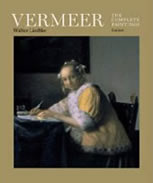
by Walter Liedtke
2008
Today, Walter Liedtke's Vermeer: The Complete WorksWalter Liedtke, Vermeer: The Complete Works (London: Abrams, 2008). stands as the most powerfully written and finely reasoned catalogue raisonné of the Dutch master.
As the author himself muses, at the time the volume was published, "it might be thought that were are already quite a number of books on Veremeer and that another one is not needed. However, the best monographs on the Delft painter—those by Blankert, Gowing, Nash, and Wheelock—now appear rather dated in form or content, and all the more recent books on the artist have particular concerns or agendas, such as the possible influence on his work of the camera obscura, Neoplatonic philosophy, or Catholicism; the painter's technique and materials; the 'phenomenon of time' or some other concept conceivably of interest to academic enthusiasts; the critical reception of Vermeer's paintings in later periods; or the usefulness of his imagery for writers who wish to reveal themselves as modern-day Prousts or Rilkes."Walter Liedtke, Vermeer: The Complete Works (London: Abrams, 2008)\.
This monograph offers a comprehensive take on Vermeer's work, blending modern scholarship with wit, intuition, and finely balanced critique. Vermeer's artistry, rich in nuance, requires deeper insight than that of many contemporaries. The author has long studied artists' original intentions and how their work resonated over time. While it is nno simple task to strip away later interpretations, glimpses of original intent shine through. Unlike previous books in the series that catalogued vast arrays of artworks, Liedtke's volume dives deeper into Vermeer's limited oeuvre.It doesn't explore his 1860s "rediscovery," his historical reception, or the fake "Vermeers" of the early 20th century. Such topics, however, have been addressed in other monographs and articles, including works by Frances Suzman Jowell and Christiane Hertel.
The large-scale illustrations and sumptuous details do justice to the book's large-scale ambitions.
2. Biography and Family
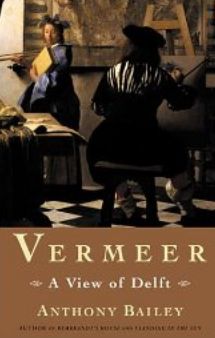
Anthony Bailey
2001
In Vermeer: A View of Delft, Anthony Bailey, a British writer and art historian, presents an intriguing portrait of Vermeer's life and character. He re-creates the atmosphere of the times, introduces the reader to Vermeer's colleagues and portrays his domestic life in vibrant detail. He also sheds light on the science and artistry behind his most representative works.
"Bailey, a New Yorker staff writer and author of two studies of Rembrandt-relates Vermeer's sketchy life in a leisurely and expert fashion. He surrounds the paucity of facts with some cautious speculation, an occasional poetical flourish, brief analyses of the paintings, and a series of vignettes about life in seventeenth-century Delft. William the Silent, tulipmania, the wars with England and France, Anthony von Leeuwenhoek's discoveries with the microscope, tile-making, the artistic use of the camera obscura—all these give heft and context to the intelligent guesses about Vermeer's life, career and painting practices. In his last two chapters Bailey traces the fortunes of Vermeer's later reputation, touching on market values, the notorious Van Meegeren forgeries, and Proust's beatification of the painter in A la Recherche du Temps Perdu.
'Though his focus is historical rather than art historical, Bailey rises periodically to a kind of impressionistic criticism, often rounding off a chapter by recreating verbally, as in the following paragraph, some of the quiet intensity of Vermeer's extraordinary tableaux:
"The painter thwarts our incessant demands for a story-line by freezing the action, by bringing time to a stop for an instant or two while contemplation exercises its power. The passivity or stillness he creates, reflecting his own nature, is in its way more dramatic, more active, than any action. So the young woman with a metal water jug pauses, one hand on the jug, one hand on the frame of the casement window which she seems about to open further, and the earth for a moment ceases to spin on its axis. So the woman in blue's downcast gaze travels along the lines of the letter she has received, word by word by word, over and over. Vermeer seizes the moment and it repeats itself indefinitely, And in the same way his milkmaid, his figure of Fortitude, tips her jug and the milk falls from it in a silent stream forever'."Michael Dirda, review of VERMEER A View of Delft by Anthony Bailey, The Washington Post, April 29, 2001, accessed October 20, 2023. Carefully researched and elegantly written, Vermeer: A View of Delft, will stand as the go-to work on Vermeer for years to come.
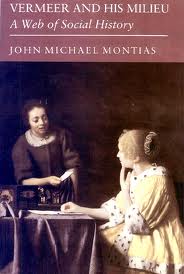
John Montias
1989
Vermeer and His Milieu: A Web of Social History by John Michael Montias is not only a fascinating biography of one of the greatest painters of the seventeenth century but a social history of the colorful extended family to which he belonged and of the town life of the period. It explores a series of distinct but contiguous worlds: Delft's Small-Cattle Market, where Vermeer's paternal family settled early in the century; the milieu of shady businessmen in Amsterdam that recruited Vermeer's grandfather to counterfeit coins; the artists, military contractors, and Protestant burghers who frequented the inn of Vermeer's father in Delft's Great Market Square; and the quiet, distinguished "Papists Corner" in which Vermeer, after marrying into a high-born Catholic family, retired to practice his art, while retaining ties with wealthy Protestant patrons. The relationship of Vermeer to his principal patron is one of many original discoveries in the book. No detail of Vermeer's life is overlooked, at lease until 2003 with the publication of Gregor Weber's Johannes Vermeer: Faith, Light and Reflection (2023). Gregor Weber, Johannes Vermeer: Faith, Light and Reflection (Rotterdam: nai010 publishers, 2023).
"[With Montias] the past is hard put to hide what were in all truth its secrets. One will read Vermeer and His Milieu several times, as [Montias] has read the archives; he is an indispensable companion for anyone who likes the seventeenth century." —Lawrence Gowing, The [London] Times Literary Supplement.
3. Interpretation
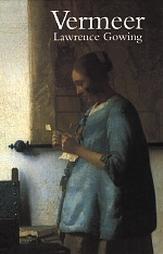
Lawrence Gowing
1955 and 1970
Lawrence Gowing's classic study has long been treasured for the painterly sensibilities he brought to this greatly loved body of work."Brilliant analysis. Must surely rank as one of the most profound interpretations of a painter ever written."—Burlington Magazine According to many, it is essential Vermeer reading, although a word of caution must be said.
Despite its many insights, as Walter Liedtke wrote, "Gowing wrote somewhat like Vermeer painted. Unless one is prepared to dedicate ten or more minutes per page, much of what he expressed might be missed. Furthermore, even the most proficient non-native English speakers may not fully grasp some of Gowing's observations."
Apart the profound influence Gowing's study had on Vermeer's studies, E. H. Gombrich, the emminent English art historian, found much to criticize about Gowing's idiosyncratic approach.E. H. Gombrich, "The Artist's Vision," review of Vermeer by Lawrence Gowing, The Observer, London, 7 September 1952.. He claims that the author primarily focuses on understanding the psychology of the artist rather than the viewer's vision. He aims to delve deep into Vermeer's style to uncover the artist's elusive personality. Gowing speculates that Vermeer's meticulous observation might be a compensation for some profound internal struggle. He suggests that Vermeer's delicate approach to figure painting indicates a cautiousness, perhaps even fear, in his attitude. However, drawing direct parallels between an artist's style and personality can be simplistic. While Gowing's book might steer clear of being trivial, its saving grace is the consistent interpretation applied at every level. He presents the camera cabinet as a metaphorical space where Vermeer, shielded by curtains, can observe without commitment. Gowing offers a comprehensive analysis of Vermeer's subjects, connecting them to the erotic genre-pieces of that era.
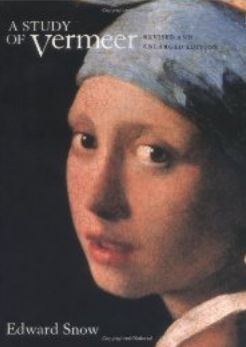
Edward A. Snow
1994
Edward Snow's A Study of VermeerEdward Snow, A Study of Vermeer (Berkeley: University of California Press, 1994). starts from a single premise: that we respond so intensely to Vermeer because his paintings reach so deeply into our lives. Our desire for images, the distances that separate us, the validations we seek from the still world, the traces of ghostliness in our own human presence—these, the book proposes, are Vermeer's themes, which he pursues with a realism always in touch with the uncanny. As Snow traces the many counterpoised sensations that make up Vermeer's equanimity, he leads us into a world of nuances and surprise.
A Study of Vermeer is passionate and visual in its commitments. Snow works from the conviction that viewing pictures is a reciprocal act—symbiotic, consequential, real. His discussions of Vermeer's paintings are conducted in a language of patient observation, and they involve the reader in an experience of deepening relation and ongoing visual discovery. The book has been designed to facilitate this process: over eighty illustrations, fifty-nine in color (including two full-page foldouts), accompany the text so that the details Snow illuminates will be continually in view. Here is a book to enthrall not only students of Vermeer, but anyone who feels the exhilaration of what Cézanne called "thinking in images."

Pieter Roelofs and Gregor J. M. Weber
2023
Published to accompany the once-in-a-lifetime exhibition at the Rijksmuseum, Amsterdam, this is the first major study of Vermeer’s life and work in many years.
Johannes Vermeer's intensely quiet and enigmatic paintings invite the viewer into a private world, often prompting more questions than answers. Who is being portrayed? Are his subjects real or imagined? And how did he create such an unrivaled sense of intimacy? Bringing together diverse strands of the Dutch master's professional and private worlds, this is the first major authoritative study of Vermeer's life and work for many years shedding light on all thirty-seven of his paintings.
With a wide selection of contextual illustrations, commentaries, and up-to-date research by distinguished international Vermeer scholars, this is, perhaps, the definitive volume on the most admired of all seventeenth-century Dutch masters. The initial pages feature each image with a catalog number, title, date, canvas size, location and/or ownership provenance, and cross-reference page numbers where the piece is mentioned throughout the volume. Nearly half of the book is dedicated to larger reproductions,
Admittedly, in organizing the event, the exhibiton curators Pieter Roelofs and Gregor Weber faced significant obstacles regarding both exhibiton and the catalogue. Typically, exhibition catalogues for large-scale exhibitions feature a series of articles written by authoritative specialists. These articles are followed by a detailed examination of each painting in chronological order, complete with illustrations, details, aesthetic considerations, literature and provenance. This format was used for the iconic Vermeer exhibition held in Washington and The Hague in 1994-1995. To avoid direct comparison with the Washington catalogue, the authors of the Amsterdam catalogue chose to deviate from the conventional layout. They organized the catalog similarly to the exhibition itself, by broader themes, in this case, nine. While this approach allows writers and readers to delve deeper into the principal themes behind Vermeer's paintings, it doesn't address Vermer's paintings individually. Consequently, there is no overarching sense of the temporal evolution of Vermeer's work or sustained discusion of individual works. This layout makes it challenging for the average reader to grasp a clear understanding of individual pieces and how Vermeer's artistry evolved during his brief 20-year career. Paintings appear scattered, and readers encounter them only when they are relevant to a particular theme. Nonetheless, the catalog boasts a wealth of insights and technical findings from the years succeeding the Washington exhibition. Of particular note is the chapter titled "Closer to Vermeer: A Look Inside the Family Home of the Delft Painter."Piter Rolelofs, "Closer to Vermeer: A Look Inside the Family Home of the Delft Painter," in VERMEER, ed. Pieter Roelofs & Gregor Weber, Rijksmuseum, Amsterdam, 2023, 42-99.
A word of caution: despite the ambitious scope of the exhibition and its catalog, the reproductions fall short of expected standards. The book was crafted by Irma Boom, often hailed as the 'Queen of Books', and printed on a specially commissioned uncoated "Munken Print White" paper to ensure color accuracy. Irma Boom asserts that "the matte paper brings you closer to Vermeer; there's no intervening gloss or glare, mirroring the genuine artworks." However, in reality, Vermeer's paintings, like all historical oil paintings, are universally finished with a standard semi-glossy varnish.When restoring the works of great masters, conservators typically use varnishes that are both reversible (meaning they can be removed without damaging the underlying paint) and stable (meaning they won't yellow or deteriorate over time). The choice of varnish can depend on the specific artwork, its condition, and the intended effect. A commonly used varnishe is Dammar: A natural resin derived from a type of tree found in East Asia, which has been used for centuries and provides a attractive gloss, and can be easily removed when it discolors over time. This enhances the depth of the dark tones and replicates the conditions in which these artworks were originally intended to be viewed. The matte finish of the catalogue saps the illustrations of their depth, imparting them with an uncharacteristic pastel appearance.
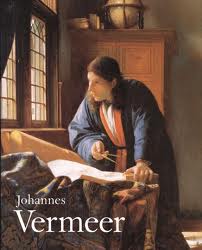
Arthur K. Wheelock Jr. et al.
1995
This lavishly illustrated exhibition catalogue dedicated to the Vermeer exhibiton held at the National Gallery, Washington D.C. and the Mauritshuis, The Hague 1995–1996remains one of the most cited and credible studies of Vermeer and his art. Up-to-date analysis of the iconography, artistry, and history of the painter. It contains many original insights and news of discoveries about Vermeer's technique and use of single-point perspective. Each of the 21 paintings in the exhibition are analyzed thoroughly by Arthur K. Wheelock Jr., one of the most knowledgeable and insightful Vermeer specialists.
It requires some knowledge of Vermeer and Dutch painting to appreciate, but the effort is well worth it.
4. History and Background
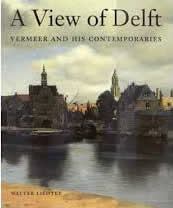
Walter Liedtke
2001
This book is a collection of writings on aspects of painting in Delft during the period 1650-1675. Walter Liedtke, highly respected curator and scholar of Dutch and Flemish art, discusses at length the work of four artists: Carel Fabritius, Gerard Houckgeest, Pieter de Hooch, and Johannes Vermeer. Liedtke considers recent interpretations and research on these artists' works, exploring in particular the relationship between style and observation in their paintings. The book begins by examining the question of whether such a community or tradition as the "Delft School" ever existed and by reviewing earlier opinions on the matter. The second chapter is devoted to Fabritius's small townscape A View in Delft, its reconstruction as an illusionistic image originally mounted in a perspective box, and the painting's significance in the narrow and in the broadest sense. In the third chapter, Leidtke focuses on a specialized genre in Delft views of actual church interiors--and offers another explanation of how naturalistic paintings, even those that carefully record existing sites, inevitably depend upon pictorial precedents. The fourth chapter on De Hooch and the "South Holland" tradition of genre painting prepares the way for the fifth, a look at Vermeer's early work. In the final chapter, the author considers Vermeer's work as a mature artist, one who has completely mastered his means.

Wayne Franits
2004
The appealing genre paintings of great seventeenth-century Dutch artists—Vermeer, Steen, de Hooch, Dou, and others—have long enjoyed tremendous popularity. This comprehensive book explores the evolution of genre painting throughout the Dutch Golden Age, beginning in the early 1600s and continuing through the opening years of the next century. Wayne Franits, a well-known scholar of Dutch genre painting, offers a wealth of information about these works and about seventeenth-century Dutch culture, its strengths, predilections, foibles, and prejudices. The author approaches genre painting from a variety of perspectives, examining their reception among contemporary audiences and setting the works in their political, cultural, and economic contexts.
Both the choice and quality of the illustrations are admirable. Anyone even vaguely interested in Dutch genre painting (scenes of daily life) will find this volume enlightening.
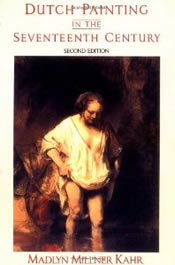
Madlyn Millner Kahr
2nd edition 1992
Artists like Rembrandt, Vermeer, Hals, Ruisdael, Cuyp, de Witte, Van Goyen, Van de Velde, Saenredam, and De Hooch are just some of the painters whose works document the uniqueness, vitality, and genius of seventeenth-century Dutch painting. It was an age of discovery of the natural world and of the everyday world. There was a new humanization of art and a rich and varied range of subject matter in Dutch painting of this period.
Madlyn Kahr describes and interprets this fascinating period as a whole and the different artists and their most notable works, providing a fresh appraisal and understanding.
VERMEER FAQ |
|
| Where can I find Vermeer's paintings? | See the interactive map of the geographical location in Vermeer's paintings in Europe and America or access detailed information about the museums in which they are housed, |
| How many paintings by Vermeer are there? | See all 35 (36?) paintings on the complete online Vermeer catalogue with dimensions, geographical locations and in-depth information about each work. |
| What was Vermeer's life like? | See a biography Vermeer's life, a detailed timeline of Vermeer's life and times, a chronology, Vermeer's children, Vermeer's wife and even a detailed interactive, family tree. |
| Are there any special exhibitions of Vermeer's paintings going on now? | See the special events page with Vermeer and Vermeer-related exhibitions. |
| How can I stay updated on special Vermeer exhibitions and new publications? | Subscribe free to the Essential Vermeer Newsletter and stay informed about Vermeer exhibitions, multi-media events, and conferences. |



































